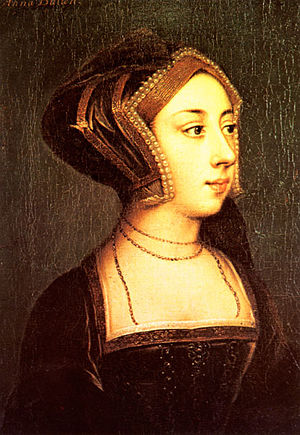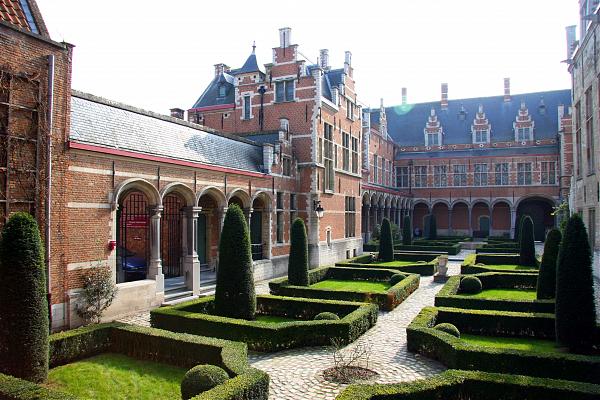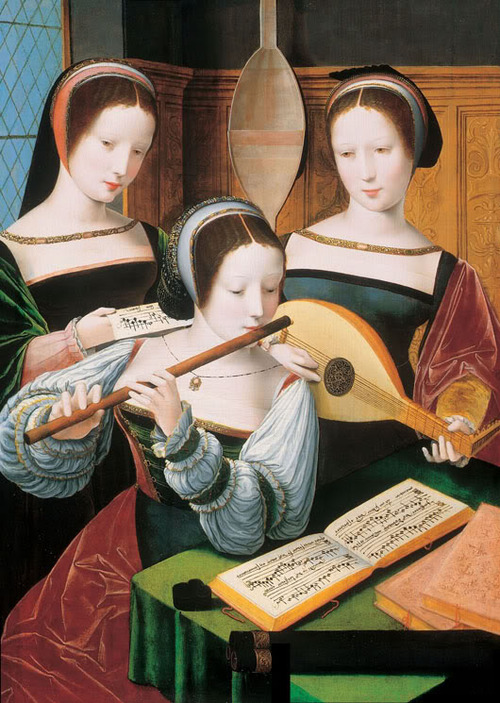ANNE BOLEYN: MUSICAL LEGEND AND THE MS 1070
By Brooke C. Little
It seems that the large body of information concerning Anne Boleyn’s musical life has been a combination of rumor and urban myth, what is for certain is that the idea of musical involvement and Anne are nearly synonymously associated. Although few primary accounts survive of her music making, she was also the queen whose musical attributes are most mentioned, both contemporaneously and posthumously. For the past five centuries, Anne Boleyn has been a source of fascination for historians, researchers and musicologists alike. Of all of Henry’s six queens, she has been the most written about in the world of musicology and English history.
As foreign ambassador to the King, Thomas Boleyn had the connections necessary to place both of his daughters in prominent positions at foreign courts during their formative years. Both Anne and Mary began their educations as dames d’honneur to Margaret of Austria in the Netherlandish court of Mechelen Palace in 1513.
Anne received formal education in singing, dancing, and instrumental music at Margaret’s court. Surrounded at court by a large population of both vocal and instrumental performers and instructors, Anne would have been educated in both types of music making, including the clavicord, manicordium, lute, and other “melodious instruments”. In addition to learning to perform on instruments, Anne would have learned court dance, and more specifically dances that integrated theatrical performances. Dancing and participating in court dance was one of the primary duties of the filles d’honneur. The Mechelen books of dance from this period include music for one of the most common dances for couples at the time, the basse dance.
The women in this portrait are portrayed in typical courtly sixteenth century domestic music making. Anne, like these women, perhaps played the French piece depicted here, Jouissance Vous Donneray by Claudin De Sermisy.
After a year spent in Mechelen, both Anne and Mary were recalled to assist Mary Tudor in her marriage to the French King at the court at France. There is very little, if any, contemporary evidence of either woman’s time in France. There is a “Mademoiselle Boleyn” who is mentioned in the 1514 retinue of Mary Tudor’s wedding to Louis XII, although it does not say whether the young lady was Anne or Mary. Another later source, quoted by Agnes Strickland in Lives of the Queens of England, describes Anne Boleyn and her musical talents as told through the perspective of Viscount Chateabriant, who was a courtier at Francis I. The Viscount conveys Anne’s infinite musical charms saying:
She possessed a great talent for poetry, and when she sun[g?], like a second Orpheus, she would have made bears and wolves attentive. She like-wise danced the English dances, leaping and jumping with infinite grace and agility. Moreover, she invented many new figures and steps, which are yet known by her name, or by those of the gallant partners with whom she danced them. She was well skilled in all games fashionable at court. Besides singing like a siren, accompanying herself of the lute, she harped better than King David, and handled cleverly both flute and rebec.
The French courtier made several observations concerning Anne’s musical ability. First, he praised not only her talents in music but also in poetry and dance composition. He lauded her abilities to captivate an audience, even captive animal onlookers. A seductive undercurrent runs throughout this observation, as he commented on her “jumping” and “leaping” which at the time such movement would have been highly scandalized for a female to perform in public. He even compared Anne to a “siren” whom by nature were dangerous creatures who lured sailors to rocky shores with their enchantment and music. Even more, Chateaubriant portrayed Anne playing the phallic shaped flute, an instrument that insinuated iconic sexual connotations for female performers.
Few possessions of Anne’s still survive to this day. What does survive are three Books of Hours that gradually become more religiously progressive the later in life she owned them. Most importantly, an early sixteenth-century manuscript called the MS 1070, also controversially called the “Anne Boleyn Songbook” by modern scholars, includes both secular and sacred vocal works that are primarily in Latin and French. Earlier researchers like Edward Lowinsky speculated about the specific time Anne owned the manuscript, arguing she may have owned it after becoming queen; he even hypothesized alternative owners of the manuscript. Some twenty years later, Lisa Urkevich has confirmed through watermark study that Anne did, in fact, own the manuscript prior to her queenship. This small inscription, found at the bottom of f. 79 reads “Mris A Bolleyne Now Thus” and identifies Anne as ‘Mistress’. This may in fact tie Anne to her time before her elevation to marquess and queen; even as late as 1532. Furthermore, the inscription “Now Thus” inextricably links the manuscript to the Boleyn family, by the inscription of the family motto.
More important than the timeline of Anne’s ownership of the manuscript is the collection of songs contained inside. While the primarily sacred musical content of this songbook may reflect Anne’s piety, it also imitates the pervasive musical tastes of the French court. Like the portrait of the three ladies mentioned previously, Anne’s manuscript too, contains the secular work Jouissance Vous Donneray, so it is quite likely that Anne herself may have performed the piece in private. Furthermore, the small size of the manuscript, indicates that it would be used for domestic music making, for either solo or small ensemble use. [5] Musicians like Jean Mouton, Antoine Brumel, Loyset Compère, Claudin de Sermisy, and even the famous Josquin De Pres make up the vast majority of works found in the manuscript, and each either served with Louis XII or Francis I.

6. MS 1070, “Anne Boleyn Songbook”, f. 113v Jouissance Vous Donneray. Royal College of Music London.
Unlike her predecessor, Katherine of Aragon, Anne’s greatest association with music was not her possession or patronage of musicians, but rather her performances. More than any other of the six queens, her musical performance has been speculated about, mused over, and written on. Even in the varying court chronicler accounts Anne’s musical activities contain a certain vivid theatric flare that is unique to only her as queen.
Alamire- Jouissance Vous Donneray- Soloist Claire Wilkinson
Read Part 1 – CATALINA DE ARAGONIA- MUSICA, LA GRANADA Y CANCIONES DE PÉRDIDA NIÑOS
Notes
Alamire. Anne Boleyn’s Songbook-Music & Passions of a Tudor Queen.David Skinner.
CD 715.Liner notes by David Skinner, Obsedian Records,2015.
Linda Phyllis Austern, “Sing Againe Syren: The Female Musician and Sexual Enchantment in Elizabethan Life and Literature,” The Renaissance Quarterly 42, no. 3 (1989): 430.
Eric Ives, The Life and Death of Anne Boleyn (Blackwell Publishing: Oxford, 2005), 15-17.
Edward Lowinsky, “MS 1070 of the Royal College of Music,” Proceedings of the Royal Music Association 96 (1969-1970): 1-28.
Elizabeth Norton, The Anne Boleyn Papers (Gloucestershire: Amberly Press, 2013).
Agnes Strickland, Lives of the Queens of England From the Norman Conquest (Blanchard and Lea: Philadelphia, 1840), 571.
Emily Winerock “‘Performing’ Gender and Status on the Dance Floor in Early Modern England,” in The Sacralizing of Space and Behavior in the Early Modern World, ed. Jennifer Mara De Silva (Burlington, VT: Ashgate, 2015), 240.
Lisa Urkevich, “Anne Boleyn, A Music book and the Nothern Renaissance Courts: Music Manuscript 1070 of the Royal College of Music London” (Ph.D. diss., University of Maryland, 1997).
MS 1070, Royal College of Music: London. Manuscript. The measurements of the document are 287 x 190 mm which would be the perfect size for a handheld manuscript.
[1] Portrait of Anne Boleyn: Hever Castle, Kent, England
[2] Current Day-Mechelen Palace: Mechelen, Belgium.
[3] Three Ladies Making Music by Master of the Female Half Lengths ca. 1530
[4] MS 1070, “Anne Boleyn Songbook”, f. 79. Royal College of Music, London.
[6] MS 1070, “Anne Boleyn Songbook”, f. 113v Jouissance Vous Donneray. Royal College of Music London.
About the Author
 Brooke Little is a researcher, writer and music instructor living in the United States with her husband and two cats. She graduated in 2001 with a BM in vocal performance and in 2008 with an MME in Music Education from the University of Missouri-Columbia. She has recently completed her second masters degree in Musicology from the Conservatory at the University of Missouri- Kansas City. Her masters thesis entitled “The Musical Lives of Henry VIII’s Six Wives” was completed in December 2017. Brooke has conducted research at the Royal College of Music London, Lambeth Palace Library, the British Library, and the National Archives at Kew. She presented her work on Jane Seymour and Anne of Cleves at the Sixteenth Century Society Conference in Milwaukee, WI in October 2017. She plans to continue her study of Tudor women’s musical lives through doctoral study. Brooke is committed to re-telling the story of each queen through the perspective of their individual musical involvement and contribution.
Brooke Little is a researcher, writer and music instructor living in the United States with her husband and two cats. She graduated in 2001 with a BM in vocal performance and in 2008 with an MME in Music Education from the University of Missouri-Columbia. She has recently completed her second masters degree in Musicology from the Conservatory at the University of Missouri- Kansas City. Her masters thesis entitled “The Musical Lives of Henry VIII’s Six Wives” was completed in December 2017. Brooke has conducted research at the Royal College of Music London, Lambeth Palace Library, the British Library, and the National Archives at Kew. She presented her work on Jane Seymour and Anne of Cleves at the Sixteenth Century Society Conference in Milwaukee, WI in October 2017. She plans to continue her study of Tudor women’s musical lives through doctoral study. Brooke is committed to re-telling the story of each queen through the perspective of their individual musical involvement and contribution.





















I really enjoyed reading this article. Thank you.
These are my ancestors. What amazing articles. Thank you